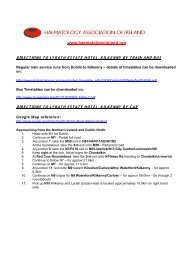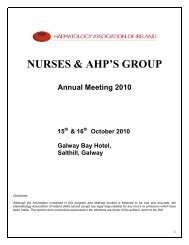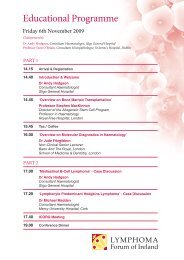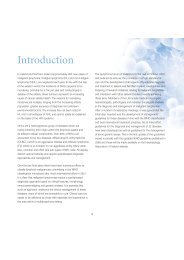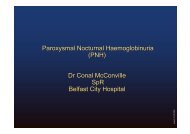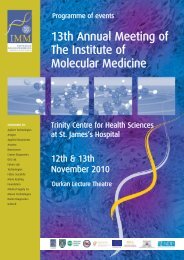Guidelines on Diagnosis and Treatment of Malignant Lymphomas
Guidelines on Diagnosis and Treatment of Malignant Lymphomas
Guidelines on Diagnosis and Treatment of Malignant Lymphomas
Create successful ePaper yourself
Turn your PDF publications into a flip-book with our unique Google optimized e-Paper software.
Immunodeficiency Associated<br />
Lymphoproliferative Disorders<br />
HUMAN IMMUNODEFICIENCY<br />
VIRUS-RELATED LYMPHOMAS<br />
Definiti<strong>on</strong> <strong>and</strong> Incidence<br />
<strong>Lymphomas</strong> that develop in HIV-positive patients are<br />
predominantly aggressive B-cell lymphomas. In a proporti<strong>on</strong> <strong>of</strong><br />
cases they represent the AIDS-defining illness. These disorders<br />
are heterogeneous <strong>and</strong> include lymphomas comm<strong>on</strong>ly diagnosed<br />
in immunocompetent patients, as well as some seen more<br />
comm<strong>on</strong>ly in the setting <strong>of</strong> HIV infecti<strong>on</strong>. The most comm<strong>on</strong><br />
HIV-associated lymphomas include: Burkitt lymphoma (BL),<br />
diffuse large B-cell lymphoma (DLBCL), <strong>of</strong>ten involving the<br />
central nervous system, primary effusi<strong>on</strong> lymphoma (PEL) <strong>and</strong><br />
plasmablastic lymphoma <strong>of</strong> the oral cavity <strong>and</strong> Hodgkin lymphoma.<br />
Clinical Presentati<strong>on</strong><br />
Clinical presentati<strong>on</strong>s are similar to those found in<br />
immunocompetent patients, but usually are more advanced with<br />
bulky disease reflected by a high LDH level. There is a significant<br />
relati<strong>on</strong>ship between the subtype <strong>of</strong> lymphoma <strong>and</strong> the HIV<br />
disease status. DLBCL usually occurs late in the course <strong>of</strong> AIDS<br />
with a prior history <strong>of</strong> opportunistic infecti<strong>on</strong> <strong>and</strong> low CD4 count<br />
usually 200x10 6 . Primary<br />
effusi<strong>on</strong> lymphoma (PEL) <strong>and</strong> plasmablastic lymphoma <strong>of</strong> the oral<br />
cavity occur in HIV+ patients almost exclusively. PEL typically<br />
presents with a pleural or perit<strong>on</strong>eal effusi<strong>on</strong> but can present as a<br />
solid tumour mass. Plasmablastic lymphoma <strong>of</strong> the oral cavity<br />
presents as a rapidly growing tumour <strong>of</strong> the jaw or oral cavity.<br />
The incidence <strong>of</strong> all subtypes <strong>of</strong> NHL is increased 60-200 fold in<br />
the HIV setting. Before the introducti<strong>on</strong> <strong>of</strong> HAART, primary CNS<br />
lymphoma <strong>and</strong> BL had an incidence 1000 fold that <strong>of</strong> the general<br />
populati<strong>on</strong>. The incidence <strong>of</strong> HL is increased about eight fold.<br />
NHL used to be the AIDS-defining illness in 3-5% <strong>of</strong> patients,<br />
but this has increased since the introducti<strong>on</strong> <strong>of</strong> HAART.<br />
This heterogeneous group <strong>of</strong> diseases reflect several<br />
pathogenetic mechanisms <strong>of</strong> lymphoma development, notably:<br />
chr<strong>on</strong>ic antigen stimulati<strong>on</strong>, cytokine dysregulati<strong>on</strong> <strong>and</strong> viral<br />
carcinogenesis involving the herpes viruses, EBV <strong>and</strong> Kaposi<br />
Sarcoma Human Virus (KSHV / HHV8).<br />
ICD – O Codes:<br />
As for cases occurring in the<br />
immunocompetent patient.<br />
Pathology <strong>and</strong> Genetics<br />
Those diseases which also present in the immunocompetent<br />
patient such as DLBCL, BL <strong>and</strong> HL will have the usual features.<br />
PEL is associated with both Kaposi sarcoma (KL) <strong>and</strong><br />
multicentric Castleman’s disease (MCD) in HIV-positive patients.<br />
In PEL the diagnosis is based <strong>on</strong> cytology with pleomorphic<br />
cells varying from large immunoblastic or plasmablastic cells to<br />
those with an anaplastic appearance. The PEL immunophenotype<br />
is EMA+ve, CD30+ve, CD38+ve , CD71 +ve <strong>and</strong> may<br />
express CD3.<br />
Plasmablastic lymphoma <strong>of</strong> the oral cavity has a diffuse pattern <strong>of</strong><br />
growth with interspersed macrophages. The tumour cells are<br />
large, with eccentric nuclei <strong>and</strong> usually a central, prominent<br />
nucleolus. The cytoplasm is deeply basophilic with a perinuclear<br />
h<strong>of</strong>. Cyctoplasmic immunoglobin can be detected in about 20%<br />
63




